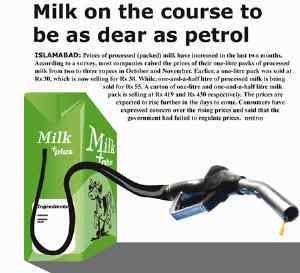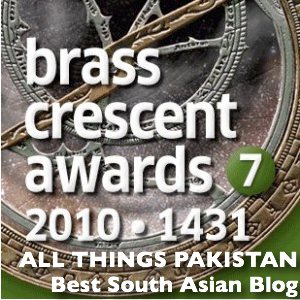Adil Najam
Our educated chattering classes do not consider it sophisticated to talk about milk.

(Photo Credit for this powerful picture: Baba Dody)
They would much rather spend their time pontificating about global geopolitics, the power politics of our would-be-saviors (both those in power and those waiting to come back to power), the intricacies of conspiracy theories about ‘hidden hands’ and not-so-hidden motives, and trying to read the ‘real’ story ‘between lines’ even as they ignore the stark realities of the lines themselves. Of course, for others there is always the option to belch out slogans reeking of pious religosity or self-righteous modernity.
 Ultimately, however, you need to think about the price of milk. Because milk is a necessity and slogans are merely a distraction.
Ultimately, however, you need to think about the price of milk. Because milk is a necessity and slogans are merely a distraction.
I know enough economics to know that while improvements in macro-economic trends matters, they matters much less when the cost of living and making ends meet for the citizenry at large run contrary. We at ATP have been and remain quite concerned about everyday inflationary trends. As we have stressed before, there is something very wrong when the denomination of the highest value banknote (Rs. 5000) is greater than what is considered a decent monthly wage for a middle-class Pakistani! We have also written about just how much it really costs ordinary Pakistanis to get petrol. Now, it turns out that the cost of milk – a daily necessity – is on the rise and moving in the same direction as the cost of petrol.
Many of us tend to think of Pakistan as a place where things are cheaper than in Europe, the US, the Middle East, or elsewhere. I don’t want to go into the math again (see here and here), but this graphic from The Daily Times (3 November, 2006), reminds us yet again that the real cost of living in Pakistan is not just higher than in most other places, for ordinary Pakistanis it is exorbitant.
The text in the graphic reports that most companies have raised the price of their one-litre packs of processed milk, and what used to sell for Rs. 30 is now selling at Rs. 38. Moreover, it reports that the price is likely to increase further.
All of this reminds me of a post Mansoor had recently written in Karachi Metroblog where he posed the question “What exactly can you do with a Million Ruppees?” The answer he came up with was, ‘Not too much!’
A lakh-patti (One Lakh=100,000) is not necessarily rich and depending of how many ‘lakhs’ one has, may even be poor!
The really sad part is that despite all this, most Pakistanis will never know what a Lakh Ruppees look like. And it is we, and not just the ‘authorities’ who are need to accept the blame. For those of you who like to get agitated about things, get agitated about this: The cruelty in society comes not only from the actions of those in power, but from the neglect, the silence, and the inaction of all of us. Indeed, from our willing participation in keeping things as they are.




















































Sridhar, Roshan, thank you for these very pertinent points. Amul is, of course, an icon in cooperative and participatory development processes. As with Yunus and Grameen, Dr. Kurien – who is teh inspiration beind the Amul idea – is someone who was able to have a great vision and also the entrepreneurial skills to turn it into reality. I remember meeting him in Ahmedabad on two sepertae trips and have learnt much from him.
There has been talk and even some attempts to apply the idea of Amul, including the milk trains that are part of its lifeline in Rajhistan and elsewhere, in Pakistan but to the best of my knowledge (Roshan may know more) these were not successful becasue the corporate milk producers were already well set in (Haleeb and others) and had already developed their networks of collection, etc. There has also been talk of trying out the cooperative model in other commodities but have not been very successful in Pakistan, partly for scale and partly for infrastructure reasons.
Sridhar,
Thanks for your prompt response. No doubt Amul is successful cooperative dairy model which has established its supply chain from farmgate to consumer. But here in Pakistan, we have one similar initiative Hala dairy (cooperative model) but it has limited outreach and has pasteurizing plant rather than Ultra High Temperature (UHT) milk treatment technology which has long shelf life for milk. The corporate sector on the other hand opted for UHT milk treatment plants and therefore having competitive advantage over cooperative initiative. Similarly, the recent dairy policy also has more thrust to promote corporatization of dairy sector rather than strengthening cooperative model.
Roshan:
Thanks for your insights on the dairy industry and dairy policy in Pakistan. This is actually one industry in which India has had a good degree of success through the cooperative route. It has its own problems, but for the most part, it has helped the small farmer get a renumerative price, while keeping prices low for the end consumer.
Bhitai:
As a comparison to the prices of milk quoted in the report, I was checking the prices in my home city of Chennai. The major supplier of milk there is the local cooperative, called Aavin (it has roughly 75% market share in the city). This is at least one case where the ministers cannot say that “India main zyada mehngi hai”.
http://www.aavinmilk.com/milk.html
Prices are similar across the country. The prices are in the Rs. 12.50/litre to Rs. 18.00/litre range for various types of milk. Even after conversion to PKR, it is way cheaper than the Rs. 30-38 quoted in these reports. And this has been made possible at least partially due to the heavy presence of cooperatives. The cooperatives have also helped greatly expand production – the white revolution has been primarily facilitated by them.
The biggest cooperative is Amul, which is the brandname of the Gujarat Cooperative Federation (each state has its own cooperative dairy operation, with its own brandname – some are more successful than the others). Amul is in fact one of the biggest brand names in the country and has a formidable marketing muscle. Even a large multinational like Unilever (a company I worked for in the past) has had to concede defeat and scale down its operations in the ice-creams market due to the drubbing it received from Amul. And it is 100% owned by the farmers.
I would imagine that Pakistan has similar grassroots strengths in the dairy industry and can potentially benefit both end-consumers and farmers through the cooperative route.
What a coincidence!!!
I am writing on Pakistan’s Dairy policy which has been recently evolved with the support of USAID. Ironically, Pakistan is the fifth largest milk producing country and has the lowest Farmgate milk prices among the major dairy producers of the world. In this regoverned market structure the milkman (gawala) or the corporate distributors who processing and selling UHT milk are minting profits while marginalizing the poor farmers and consumers.
Food for thought about our dairy policy:
The Strategic Plan for Pakistan Dairy (2006) also known as the ‘White Revolution’ identifies challenges and potential repercussions in the dairy sector of the country. The targets set in the strategic plan for the year 2015 seek to boost the competitiveness of the industry by regoverning the dairy production and marketing structure. This is to be done by first establishing model commercial dairy farms. Even in the US, which has such a modern dairy sector, the transition from small family farms to larger commercial farms has not been without social cost. The strategic plan (2006) does not represent the interests of small farmers who represent more than 70% of total farms in Pakistan. Even though increased world food supplies are a positive outcome, the ‘Green Revolution’ has also resulted ecological and economical imbalances in the rural livelihoods. Therefore, one needs to be very careful assessing the total costs and benefits of the ‘White Revolution’ especially for the subsistence farming communities. Restructuring and regoverning of dairy production and supply & marketing chain should not undermine the livelihoods concerns of rural dairy farmers. We believe that the participation of small farmers’ organization and civil society organizations should be encouraged before the implementation of the strategy.
Just the other day Mushy claimed to have reduced poverty by 10%. Obviously he presented nothing to back up his claim. Even if he had, few would believe him anyway.
Of all the excuses our ‘ministers’ make to justify inflation, one irks me the most ‘yeh cheez toe india main ziada menhgi hay’..as if Pakistan is at par with india in every other regard…